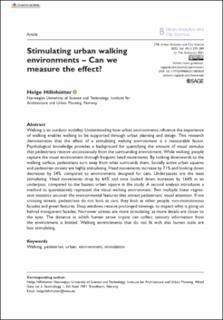| dc.contributor.author | Hillnhütter, Helge | |
| dc.date.accessioned | 2022-06-28T11:25:43Z | |
| dc.date.available | 2022-06-28T11:25:43Z | |
| dc.date.created | 2021-03-01T09:11:19Z | |
| dc.date.issued | 2021 | |
| dc.identifier.citation | Environment and planning. B: Urban analytics and city science. 2021, 49 (1), 275-289. | en_US |
| dc.identifier.issn | 2399-8083 | |
| dc.identifier.uri | https://hdl.handle.net/11250/3001306 | |
| dc.description.abstract | Walking is an outdoor mobility. Understanding how urban environments influence the experience of walking enables walking to be supported through urban planning and design. This research demonstrates that the effect of a stimulating walking environment is a measurable factor. Psychological knowledge provides a background for quantifying the amount of visual stimulus that pedestrians receive unconsciously from the surrounding environment. While walking, people capture the visual environment through frequent head movements. By looking downwards to the walking surface, pedestrians turn away from what surrounds them. Socially active urban squares and pedestrian streets are highly stimulating. Head movements increase by 71% and looking down decreases by 54%, compared to environments designed for cars. Underpasses are the least stimulating. Head movements drop by 64% and time looked down increases by 164% in an underpass, compared to the busiest urban square in the study. A second analysis introduces a method to quantitatively represent the visual walking environment. Two multiple linear regression statistics uncover the environmental features that attract pedestrians’ visual attention. If not crossing streets, pedestrians do not look at cars; they look at other people, non-monotonous facades and green features. Shop windows receive prolonged viewings, to inspect what is going on behind transparent facades. Narrower streets are more stimulating, as more details are closer to the eyes. The distance at which human sense organs can collect sensory information from the environment is limited. Walking environments that do not fit with this human scale are less stimulating. | en_US |
| dc.language.iso | eng | en_US |
| dc.publisher | SAGE | en_US |
| dc.rights | Navngivelse 4.0 Internasjonal | * |
| dc.rights.uri | http://creativecommons.org/licenses/by/4.0/deed.no | * |
| dc.title | Stimulating Urban Walking Environments – Can we Measure the Effect? | en_US |
| dc.type | Peer reviewed | en_US |
| dc.type | Journal article | en_US |
| dc.description.version | publishedVersion | en_US |
| dc.source.pagenumber | 275-289 | en_US |
| dc.source.volume | 49 | en_US |
| dc.source.journal | Environment and planning. B: Urban analytics and city science | en_US |
| dc.source.issue | 1 | en_US |
| dc.identifier.doi | 10.1177/23998083211002839 | |
| dc.identifier.cristin | 1894370 | |
| cristin.ispublished | true | |
| cristin.fulltext | preprint | |
| cristin.qualitycode | 2 | |

